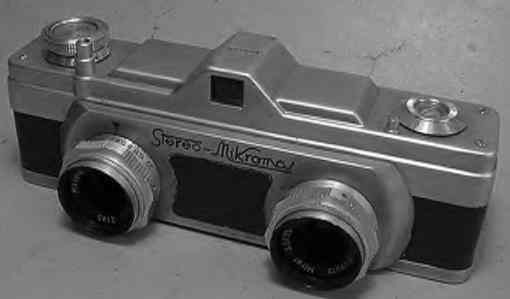

Stereo Mikroma
If two heads are better than one, can the same also be said of lenses? Well, some people think so, like the camera designers at Meopta in Czechoslovakia in 1961. So they stretched the regular Mikroma (model I at the time) and added two lenses to make stereo image pairs. Actually, it's not quite a stretched model I . The original had shutter speeds from 1/25 - 1/200. This stereo version had speeds of B, 1/5 - 1/100. The lenses were also different -- two three-element Mirar 25mm lenses (20mm on the original) with apertures from f3.5 - 16. The f-stop settings are cross-linked to help avoid exposure errors. And although the lenses look like they might be interchangeable, they are not. Another difference with the model I is the shutter release. The stereo model has a standard shutter release, a lever to cock the shutter, and the film advances with a large knob on the top -- unlike the model I which used one lever for all three functions. Last, but not least, the images are 12x13mm -- a little different from the non-stereo result. Since the stereo effect is intensified the closer you are to the subject, Meopta came out with a special snap-on close-up filter set for use up to 2 feet. It even had a viewfinder parallax adapter built in. And needless to say, they also made a special film cutter and a stereo viewer. It's obviously fairly large and weights in at one pound, but it is a quality shooter and a robust user.
COPYRIGHT @ 1995, 1996, 1997, 1998, 1999, 2000, 2001, 2002, 2003, 2004, 2005 by Joe McGloin. All Rights Reserved.